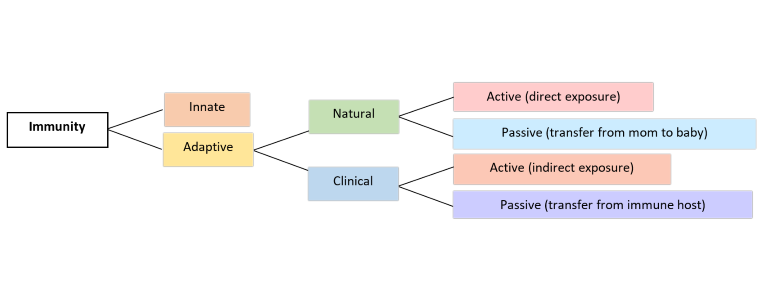Are you sure you want to leave Kandau Jain's MyShop site?
Are you sure you want to leave Kandau Jain's MyShop site?
Are you sure you want to leave Kandau Jain's MyShop site?
Are you sure you want to leave Kandau Jain's MyShop site?

In Part 1 of What are Transfer Factors, you learned about the role of your immune system and the different parts of your body that make up this intricate system. You also learned that your body’s self-defense ability is both inherited (innate immunity) and learned (adaptive immunity). The innate and adaptive portions of your immune system provide two levels of defense that work to protect you from the many invaders you encounter on a daily basis.
In Part 2 of this series, you’ll learn how your body develops immunity over your lifetime and how transfer factors support your immune defense system.

Both innate and adaptive immunity are essential for a strong defense system. These components of your immune system each play an important role in helping protect you from harmful invaders. Your innate immune system acts quickly and provides the first line of defense against invaders. Your adaptive immune system provides a second wave of defense that is more targeted and capable of producing lasting protection against invaders.
As has been noted, adaptive immunity is your acquired or learned ability to defend against invaders. The adaptive components of your immune system develop over your lifetime and provide highly effective protection against a wide variety of invaders. As explained in the immunity chart above, adaptive immunity can be classified as natural or clinical and can be further classified as active or passive. These classifications describe how you develop adaptive immunity. Below is a description of each classification.
Natural
Natural immunity is acquired through:
Clinical
Clinical immunity is acquired through:
Active
Active immunity occurs when your own immune system is responsible for protecting you from an invader. Exposure to an invader triggers an internal immune system response where various immune system components are generated to defend against the invader. Active immunity provides long-term protection since it produces immune system memory cells.
Passive
Passive immunity occurs when immune system components from someone else protect you from an invader. Unlike active immunity, which takes time to develop as your immune system works to build its defenses against the invader, passive immunity can take effect immediately. The transferred antibodies or other immune system components carry important immune system knowledge, which can be used to generate a rapid and efficient response upon exposure to an invader.
The downside to passive immunity is that it is short-lived since the transferred immune system components only stay in your system temporarily and any immune system knowledge that gets passed along to your cells is lost when those cells die. Additionally, the rapid response to the invader prevents your adaptive immune system from being activated and thus your body develops no immune system memory cells.
Now that you have a basic understanding of the inner workings of your immune system (from Part 1 of this series) and the different ways you acquire immunity, let’s take a closer look at where transfer factors come into play.
Transfer factors are proteins your white blood cells make that contain antigen-specific information. Remember: antigens are unique proteins that sit on the surface of invading cells. Each transfer factor carries an image of a specific antigen it can share with other immune system cells to help them identify and respond to invaders more quickly.

When you take a 4Life Transfer Factor product, you acquire clinical, passive immunity. Our products contain transfer factors from other mammals (cows and chickens) that have developed immunity against a wide variety of invaders. These transfer factors are structurally similar to those produced by your own cells and have been shown to behave in much the same way once they’ve entered your body.*1
When you take a 4Life Transfer Factor product, the unique set of knowledge contained in each transfer factor is passed to specific cells in your immune system. The transfer factors help your cells quickly identify and respond to invaders. The knowledge remains with your cells for the duration of their life, which is typically a few months. For this reason, the transferred immunity is temporary. Fortunately, regularly consuming 4Life Transfer Factor products would help to achieve lasting immunity against a vast number of invaders.*
The main job of your immune system is to defend your body against foreign invaders. Your immune system provides two levels of defense: innate and adaptive immunity. Both forms of immunity are vital for a strong defense system. Your innate immune system acts quickly and provides the first line of defense against invaders. Your adaptive immune system provides a second wave of defense that is more targeted and capable of producing lasting protection against invaders.
Innate immunity refers to the immune system defenses you are born with; adaptive immunity refers to the defenses you acquire over your lifetime. There are four classifications of adaptive immunity: natural, clinical, active, and passive.
Transfer factors provide a unique way to acquire immunity and strengthen your immune defense system over your lifetime. These proteins contain important immune system knowledge that can be transferred from the cells of an immune system host to your immune system cells. Your cells hold on to this knowledge for as long as they live and can use it to help them recognize and respond to invaders quickly. Due to the short lifespan of most cells, the transferred immunity is temporary. Therefore, to ensure lasting protection against a wide variety of invaders, it is beneficial to take transfer factor products on a regular basis.*
References** 1. https://www.pdr.net/full-prescribing-information/4Life-Transfer-Factor-Tri-Factor-Formula-nanofactor-transfer-factor-159
You are trying to view a MyShop page. Please log out in order to view this website.